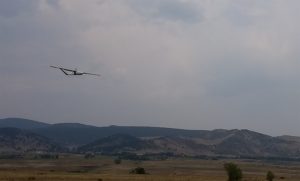NOAA has awarded Black Swift Technologies (BST) a contract to develop GPS-denied navigation, enabling Beyond Visual Line of Sight (BVLOS) operations for drones in GNSS-denied environments.
NOAA has almost 95,000 miles of domestic coastline to survey – and while drones are by far the best way to complete the mission, flying within visual line of sight (VLOS) makes the mission time-consuming, and less efficient than it could be. To complete the mission within the constraints of VLOS flight drone operators have to work in 2 mile increments, a BST press release explains: so NOAA’s contract with BST “to develop commercially viable technology enabling GPS-denied navigation of UAS—technology critical in enabling long distance, beyond visual line of sight (BVLOS) flights,” makes sense.
“Enabling BVLOS operations in the National Airspace System is largely an issue of improved sensing,” states Jack Elston, Ph.D., CEO of Black Swift Technologies. “Operators, both government and commercial, are looking to perform missions over longer distances. These users represent a number of currently under-utilized applications for UAS due to capability and regulations—applications such as aerial imaging, environmental observation, precision agriculture, and infrastructure monitoring and inspection.”
Accurate aircraft position information is essential for safe UAS operations within the Unmanned Aircraft Systems Traffic Management (UTM) system. Unfortunately, the primary system that provides position information, GPS, is a single point of failure in the system, subject to jamming and spoofing, along with on-board failure or poor signal quality in locations such as urban canyons, at high latitudes or high altitudes.
The solution could be BST’s “diverse-source global positioning system (DS-GPS).” DS-GPS provides accurate position updates to drones in GPS-denied areas “through augmented sensor suites and advanced machine learning capabilities,” says BST.
DS-GPS utilizes a standard GPS receiver augmented through the use of additional sensing capabilities to estimate inertial velocity and absolute position. This information allows for the vehicle to determine when the GPS signal is degraded either through spoofing or environmental effects. Other sensors, including cameras and a software-defined-radio, can then be used to replace the GPS as the primary navigational sensor providing position and velocity estimates from diverse sources.
“Black Swift Technologies has worked with NOAA in particular in the past to supply systems that can be used for both coastline work and atmospheric science,” Elston emphasizes. “The work in this SBIR is a natural extension of the machine learning based techniques BST has been developing for unmanned aircraft. One of the key technologies of this work is to use machine vision (both optical flow and SLAM) to allow continued safe flight of UAS in the event of loss of GPS. Work associated with coastline inspection and mapping would greatly benefit from BVLOS operations since this would significantly reduce the amount of time an operator has to spend in the field.”
The work will be a huge benefit for NOAA – but could be a game changing development for the entire industry. Dawn Zoldi, CEO of P3 Tech Consulting and internationally recognized expert on drone law and policy applauds this latest development. “Through this collaboration with NOAA, Black Swift will continue contributing to the important body of R&D that will advance BVLOS for the entire industry. What they are doing is novel and important. They are taking their initial work with NASA and NOAA on machine learning base techniques and machine vision to the next level. The end game is to allow safe flight in the event of a loss of GPS. This kind of fail-safe tech is key to enabling extended, scalable and repeatable operations – not just for government use but for the entire commercial drone industry.”
Miriam McNabb is the Editor-in-Chief of DRONELIFE and CEO of JobForDrones, a professional drone services marketplace, and a fascinated observer of the emerging drone industry and the regulatory environment for drones. Miriam has penned over 3,000 articles focused on the commercial drone space and is an international speaker and recognized figure in the industry. Miriam has a degree from the University of Chicago and over 20 years of experience in high tech sales and marketing for new technologies.
For drone industry consulting or writing, Email Miriam.
TWITTER:@spaldingbarker
Subscribe to DroneLife here.
https://dronelife.com/2021/01/19/gps-denied-navigation-black-swift-moves-drone-flight-forward-with-noaa-contract/
 Unmanned Aerial Vehicle The latest drone news
Unmanned Aerial Vehicle The latest drone news





